Soviet Space Deceptions - not so many after
all!
Sven Grahn, Sollentuna, Sweden
When the space age started
in 1957 the thirst for information about space ventures was unquenchable,
both from the public and from the media. A situation quickly emerged where
the U.S. space efforts were well publicized with plenty of technical and
human-interest details but unsuccessful, and the Soviet space launches
were conducted in secrecy and therefore failures were never revealed. The
technical details about Soviet space ventures were meagre. Sometimes they
were not correct, outright fabrications, like the well known disinformation
about the location of the launch site for Yuri Gagarin - thoroughly explored
by Jim Oberg. Interestingly, up until Gagarin's flight, Soviet public statements
about their space launches were, as far as I can ascertain, truthful, but
meagre in technical details. Yuri Gagarin's and Gherman Titov's flights
generated the first cases of deliberate disinformation about Soviet space
launches. The half-truths about the mode of landing of Gagarin and Titov
are other cases that have been explored by Jim Oberg, who has also extensively
covered the retouching of photos to remove cosmonauts that had left the
program for various reasons.
The "Great Vostok Configuration Myth"
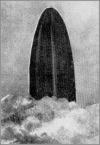 Some
technical information released by the Soviet authorities at the time were
very accurate. For example, on 7 August 1961, TASS issued a communiqué
about the continued flight of Vostok-2 and repeated the radio frequencies
used by the cosmonaut (20.006 MHz, 143.625 MHz), but added that the reports
from the cosmonaut on 143.625 MHz were frequency
modulated with a deviation of ± 30 kHz! Why
would such technical detail be released? Well, the flight would last quite
a long time, and many people around the world would have the chance to
listen in. To create maximum excitement and "propaganda effect" it was
essential that listeners around the world would be able to tune in, but
it was also important that people did so, in order to avoid any claim from
the West that the whole flight was a fake!
Some
technical information released by the Soviet authorities at the time were
very accurate. For example, on 7 August 1961, TASS issued a communiqué
about the continued flight of Vostok-2 and repeated the radio frequencies
used by the cosmonaut (20.006 MHz, 143.625 MHz), but added that the reports
from the cosmonaut on 143.625 MHz were frequency
modulated with a deviation of ± 30 kHz! Why
would such technical detail be released? Well, the flight would last quite
a long time, and many people around the world would have the chance to
listen in. To create maximum excitement and "propaganda effect" it was
essential that listeners around the world would be able to tune in, but
it was also important that people did so, in order to avoid any claim from
the West that the whole flight was a fake!
But, the Vostok flights generated
some grand pieces of disinformation. It started with the launch picture!
For some reasons those who directed the media coverage around the Gagarin
flight felt compelled to publish some kind of picture of the launch - and
the result was the one shown on the left, released in Moscow on April 14,
1961, alleged to show the nose of the Vostok launcher rising through cloud!
Why publish such a completely retouched photo after all? Maybe to tell
everyone that the launch vehicle was secret and that revealing it would
give the West dangerous information? Showing such a retouched picture is
a sort of bragging!
Naturally the interest in
the Gagarin flight was so high that some kind of public display of the
very heavy spaceship was necessary, but without revealing some essential
details about the spacecraft. One should remember, that at this time, the
sister ship of Vostok, the Zenit-2 spy satellite had not flown yet, and
revealing the configuration of Vostok would reveal the configuration of
Zenit, from which Western intelligence could glean details about its performance
as a spy satellite. Also, the very simple shape of the re-entry vehicle
may have been regarded as a bit of embarrassing to show to experts in the
West, while NASA was designing Mercury, Gemini and Apollo, the two latter
with re-entry vehicles that could manoeuvre because of their shape. So,
there were plenty of reasons to keep the actual configuration of Vostok
secret for some time.
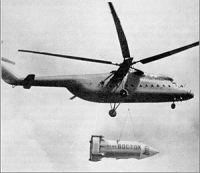 The
next step in the Vostok publicity campaign was therefore quite brilliant.
A mock-up of the last stage of the carrier rocket and the shroud covering
the Vostok was shown at the Tushino air display in July, 1961. The shroud
even included the opening for the the catapult. But - the mock-up had a
confusing addition. It had an annular aerodynamic fin arrangement at the
back. Whether this was added as a device to keep the nose of the mock-up
pointing in the direction of flight or intended as disinformation is hard
to know. Perhaps someone in Russia can shed light on this? However, this
annular fin now became a solid part of the "Vostok configuration myth"
as we shall see. It is a bit strange that nobody in the West was able to
interpret the shroud opening for the catapult as evidence for a spherical
capsule. The strange thing about the Tushino mock-up is that it actually
carried real telemetry antennas on the last stage of the carrier rocket.
The
next step in the Vostok publicity campaign was therefore quite brilliant.
A mock-up of the last stage of the carrier rocket and the shroud covering
the Vostok was shown at the Tushino air display in July, 1961. The shroud
even included the opening for the the catapult. But - the mock-up had a
confusing addition. It had an annular aerodynamic fin arrangement at the
back. Whether this was added as a device to keep the nose of the mock-up
pointing in the direction of flight or intended as disinformation is hard
to know. Perhaps someone in Russia can shed light on this? However, this
annular fin now became a solid part of the "Vostok configuration myth"
as we shall see. It is a bit strange that nobody in the West was able to
interpret the shroud opening for the catapult as evidence for a spherical
capsule. The strange thing about the Tushino mock-up is that it actually
carried real telemetry antennas on the last stage of the carrier rocket.
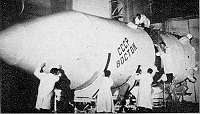 At
about the same time, i.e. in July 1961, the Soviet Union released a movie
called "With Gagarin to the Stars". In this movie there was a still picture
showing the mating of the shroud to the Vostok mounted on the last stage
of the carrier rocket. It is strange that this picture is absolutely free
from fakes, and does not show the annular ring, but still was seen as confirming
the Tushino display! The keen observer noticed the similarity between the
last stage and that of Luna 1! Pictures of the catapulted container for
the dogs carried on Sputnik 5-10 had been released and their configuration
obviously added to the confusion as we can see from the picture below.
It is a Vostok configuration sketch the seems to have been generated by
engineers at the Bendix Corporation and published in German magazine "Raketentechnik
und Raumfahrtforschung" (No. 1, 1962). It is easy to sneer at sketches
like these in this day and age, but remember what the situation was like
36 years ago. The person who drew this sketch must be forgiven for forgetting
the heat shield and other essential parts of a manned spaceship. He even
got position of the cosmonaut wrong - on his belly!
At
about the same time, i.e. in July 1961, the Soviet Union released a movie
called "With Gagarin to the Stars". In this movie there was a still picture
showing the mating of the shroud to the Vostok mounted on the last stage
of the carrier rocket. It is strange that this picture is absolutely free
from fakes, and does not show the annular ring, but still was seen as confirming
the Tushino display! The keen observer noticed the similarity between the
last stage and that of Luna 1! Pictures of the catapulted container for
the dogs carried on Sputnik 5-10 had been released and their configuration
obviously added to the confusion as we can see from the picture below.
It is a Vostok configuration sketch the seems to have been generated by
engineers at the Bendix Corporation and published in German magazine "Raketentechnik
und Raumfahrtforschung" (No. 1, 1962). It is easy to sneer at sketches
like these in this day and age, but remember what the situation was like
36 years ago. The person who drew this sketch must be forgiven for forgetting
the heat shield and other essential parts of a manned spaceship. He even
got position of the cosmonaut wrong - on his belly!
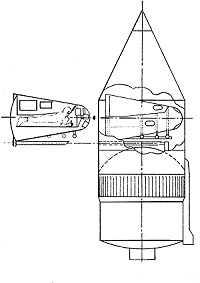
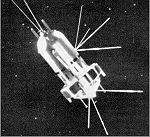 The
"Vostok configuration myth" got another injection of half-truths and disinformation
with the release of the film about Gherman Titov's flight "To the Stars
Again" in October 1961. In several scenes the orbital motion of Vostok
2 was illustrated using a model of Vostok that retained the annular fin
or "stabilizing ring" at the base, added absolutely correct details about
radio antennas and thermal shutters at the base of the craft. But - it
added another fantastic piece of disinformation: two little wings on each
side of the body (or "canard control surfaces" as Missiles & Rockets
called them). Also a green band around the waist for thermal control was
also added, and mentioned in technical descriptions of the craft - this
is obviously a non-existent part, isn't it?
The
"Vostok configuration myth" got another injection of half-truths and disinformation
with the release of the film about Gherman Titov's flight "To the Stars
Again" in October 1961. In several scenes the orbital motion of Vostok
2 was illustrated using a model of Vostok that retained the annular fin
or "stabilizing ring" at the base, added absolutely correct details about
radio antennas and thermal shutters at the base of the craft. But - it
added another fantastic piece of disinformation: two little wings on each
side of the body (or "canard control surfaces" as Missiles & Rockets
called them). Also a green band around the waist for thermal control was
also added, and mentioned in technical descriptions of the craft - this
is obviously a non-existent part, isn't it?
It is strange that the little
cylinders with pointed noses that were seen on the stabilizing ring of
the Tushino mock-up had been modified and lacked the little nose-caps.
Why change a little detail like this? Artistic license or a desire to make
the craft look more real and less like a sci-fi creation? But, half the
truth of configuration of Vostok was now out in the open. The top of the
re-entry vehicle is obviously a sphere and the size of camera that can
be put on board Vostok for reconnaissance purposes is now quite obvious.
The canards certainly do a good job at hiding the true shape of the re-entry
vehicle. It is hard to imagine there is a sphere behind the canards!
Well, let us now examine
how this movie model was interpreted by the media. The sketches below come
from the now defunct magazine Missiles & Rockets. I must say I accepted
these configuration sketches as the undiluted truth when I first saw them
in the magazine shelves of the American Library (run by the U.S. Information
Service) on the top floor of "Hotel Stockholm" at the Norrmalmstorg Square
in downtown Stockholm, a place that I could reach during the lunch break
at my high school. I went there about twice a week to read Missiles &
Rockets, Aviation Week and to pick up the mimeographed news releases about
U.S. space exploits that were available at the Library. I have kept old,
brown photo-copies (Yes, real photo-copies, no Xeroxes around in those
days) of these configuration sketches. Instead of letting them fade away
in my files I have put them on here.
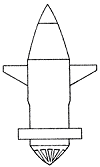 In
the December 18, 1961 issue of Missiles and Rockets the model of Vostok
2 shown in the film about Titov's spaceflight had prompted this interpretation
of the launch configuration of Vostok. The canards are longer than in the
movie and the stabilizing ring lacks the little cylinders. The thermal
shutters are included, but shown somewhat stylized. In the accompanying
text, the magazine says that "Soviet officials said Vostok II was different
from Vostok I and the wings were new. They connected them with maneuvers
Maj. Gherman Titov reportedly carried out during the last orbits of his
17½-orbit Aug. 6 flight, when he was in the denser regions of the
atmosphere". Yet another piece of disinformation! Who concocted this
whole story.....?
In
the December 18, 1961 issue of Missiles and Rockets the model of Vostok
2 shown in the film about Titov's spaceflight had prompted this interpretation
of the launch configuration of Vostok. The canards are longer than in the
movie and the stabilizing ring lacks the little cylinders. The thermal
shutters are included, but shown somewhat stylized. In the accompanying
text, the magazine says that "Soviet officials said Vostok II was different
from Vostok I and the wings were new. They connected them with maneuvers
Maj. Gherman Titov reportedly carried out during the last orbits of his
17½-orbit Aug. 6 flight, when he was in the denser regions of the
atmosphere". Yet another piece of disinformation! Who concocted this
whole story.....?
The magazine continued: "There
has been continued speculation in the west that Vostok's were winged and
that they were being designed as a military spacecraft. the model, however,
is the most concrete evidence to date that this is the case.....There are
reports that Russia is working on orbital rendezvous. the various control
surfaces of Vostok may be designed for the necessary maneuverability in
space." Well, they got one thing right - Vostok was being developed
as a military spacecraft.
The crowning achievement
of this disinformation campaign can be seen in the diagram of the Vostoks
that Missiles & Rockets published in its issue of July 9, 1962 (p.9).
This sketch contains almost everything from the Tushino air display and
the Vostok 2 film. The artist has added a Mercury-style heat shield and
retro rocket. The window is placed very far from the pilot and the parachute
of the re-entry vehicle is placed at the apex of the spherical front of
the craft. This sketch has very little in common with the real Vostok -
which of course was the purpose of the disinformation campaign!
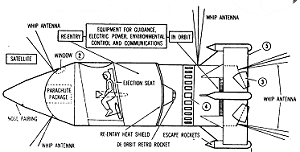
The Vostok deception ends - suddenly!
In my files there is a clipping
from a Swedish newspaper (Stockholms-Tidningen) dated April 30, 1965 showing
a picture of Vostok taken at the Exhibition of Economic Achievements in
Moscow where Vostok had been put on display. I have another newspaper article
dated May 3, 1965 where the Novosti description of Vostok is recounted
with the comment that the spherical capsule was the great surprise: "Gagarin
travelled like Baron Münchhausen- on a cannon ball" was the paper's
comment. Aviation Week published pictures from the exhibition in its May
10, 1965 issue.
The actual release of the
truth about Vostok occurred on April 29, 1965. It is interesting that just
five weeks earlier Leonov's flight in Voskhod 2 had taken place and the
lid of secrecy about Vostok was still tightly in place. Of course, everyone
thought Voskhod was a great technological leap over and beyond Vostok,
so perhaps that is why Vostok could now be revealed. Or, the fact that
the Soyuz craft was getting nearer to flight status made Vostok obsolete
and therefore possible to put on display.
In the Soviet documentary
film "Man Steps Into Space" about Leonov's spacewalk, the first glimpses
of the R-7-based launch vehicle for Vostok and Voskhod were shown. This
film reached the West in September 1965. But, it took until the Paris Air
Show in June 1967 for the Vostok booster to be shown in full detail! The
full-scale replica of the rocket carried a mock-up of the Vostok spacecraft.
Finally, we knew what Gagarin's chariot looked like. Why was the R-7 revealed
at that particular juncture? Well, perhaps it was no longer the most powerful
rocket that the Soviet Union had at its disposal. The UR-500, Proton, rocket
was now being used more and more and the less powerful rocket could therefore
be shown without revealing the true extent of Soviet capability. In fact,
we had to wait another 18 years before the Proton was being shown in public
on the occasion of the Vega launch! By that time, the Energiya rocket was
in the final stages of development, the Proton could be shown without revealing
the true extent of Soviet launch vehicle capability. The logic seems to
be same, doesn't it? Anyone who has knowledge about Soviet censorship policy
is invited to comment on this and the whole article of course!
The last elaborate fake - the configuration
of Soyuz hidden for 18 months
When Soyuz was launched in April
1967, everyone realized it was a new ship and that the design must differ
from that of Vostok. The disaster that followed shook everyone and the
Soviet Union's space prowess did not seem so overwhelming. However, the
primary objective of the Soyuz 1/2 flight - rendezvous and docking was
brilliantly carried out with two unmanned craft in October 1967, a mere
6 months after the death of Vladimir Komarov in Soyuz 1. Cosmos 186 and
188 were of course nothing but two Soyuz vehicles. The feat of docking
them automatically was not small and the Soviet publicity machine naturally
wanted to take advantage of this triumph. For some reason, perhaps the
continuing investigation into the death of Komarov, it was deemed necessary
to keep the real configuration of Soyuz secret. Again, it was the shape
of the re-entry vehicle that needed to be hidden. Why?? The picture below
was released by Soviet authorities in early November 1967. The area between
the orbital module and descent vehicle has been heavily retouched to hide
the shape of the descent vehicle. Of course, just a year later the true
shape of Soyuz was revealed in connection with the flight of Georgi Beregovoy
in Soyuz 3.
The interesting thing about
the picture below is the fact that all antennas are correctly shown. I
used this picture to determine that the U-shaped antennas at the solar
panel tips were designed for 165-185 MHz. As it turned out this was more
accurate than I could imagine. That is precisely the band in which several
telemetry frequencies were located on early Soyuz craft. In general, I
have never been able to detect that antennas on Soviet spacecraft models
or sketches were distorted in any way. Somewhat surprising, but true -
it seems.
The Soviet censors did perpetrate
some lies and fakes, but no so many - actually. Usually, I must conclude,
the information released by Soviet authorities was meagre, but truthful.
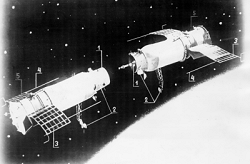

 Back
to Space History Notes
Back
to Space History Notes
 The
next step in the Vostok publicity campaign was therefore quite brilliant.
A mock-up of the last stage of the carrier rocket and the shroud covering
the Vostok was shown at the Tushino air display in July, 1961. The shroud
even included the opening for the the catapult. But - the mock-up had a
confusing addition. It had an annular aerodynamic fin arrangement at the
back. Whether this was added as a device to keep the nose of the mock-up
pointing in the direction of flight or intended as disinformation is hard
to know. Perhaps someone in Russia can shed light on this? However, this
annular fin now became a solid part of the "Vostok configuration myth"
as we shall see. It is a bit strange that nobody in the West was able to
interpret the shroud opening for the catapult as evidence for a spherical
capsule. The strange thing about the Tushino mock-up is that it actually
carried real telemetry antennas on the last stage of the carrier rocket.
The
next step in the Vostok publicity campaign was therefore quite brilliant.
A mock-up of the last stage of the carrier rocket and the shroud covering
the Vostok was shown at the Tushino air display in July, 1961. The shroud
even included the opening for the the catapult. But - the mock-up had a
confusing addition. It had an annular aerodynamic fin arrangement at the
back. Whether this was added as a device to keep the nose of the mock-up
pointing in the direction of flight or intended as disinformation is hard
to know. Perhaps someone in Russia can shed light on this? However, this
annular fin now became a solid part of the "Vostok configuration myth"
as we shall see. It is a bit strange that nobody in the West was able to
interpret the shroud opening for the catapult as evidence for a spherical
capsule. The strange thing about the Tushino mock-up is that it actually
carried real telemetry antennas on the last stage of the carrier rocket.
 Some
technical information released by the Soviet authorities at the time were
very accurate. For example, on 7 August 1961, TASS issued a communiqué
about the continued flight of Vostok-2 and repeated the radio frequencies
used by the cosmonaut (20.006 MHz, 143.625 MHz), but added that the reports
from the cosmonaut on 143.625 MHz were frequency
modulated with a deviation of ± 30 kHz! Why
would such technical detail be released? Well, the flight would last quite
a long time, and many people around the world would have the chance to
listen in. To create maximum excitement and "propaganda effect" it was
essential that listeners around the world would be able to tune in, but
it was also important that people did so, in order to avoid any claim from
the West that the whole flight was a fake!
Some
technical information released by the Soviet authorities at the time were
very accurate. For example, on 7 August 1961, TASS issued a communiqué
about the continued flight of Vostok-2 and repeated the radio frequencies
used by the cosmonaut (20.006 MHz, 143.625 MHz), but added that the reports
from the cosmonaut on 143.625 MHz were frequency
modulated with a deviation of ± 30 kHz! Why
would such technical detail be released? Well, the flight would last quite
a long time, and many people around the world would have the chance to
listen in. To create maximum excitement and "propaganda effect" it was
essential that listeners around the world would be able to tune in, but
it was also important that people did so, in order to avoid any claim from
the West that the whole flight was a fake!



 In
the December 18, 1961 issue of Missiles and Rockets the model of Vostok
2 shown in the film about Titov's spaceflight had prompted this interpretation
of the launch configuration of Vostok. The canards are longer than in the
movie and the stabilizing ring lacks the little cylinders. The thermal
shutters are included, but shown somewhat stylized. In the accompanying
text, the magazine says that "Soviet officials said Vostok II was different
from Vostok I and the wings were new. They connected them with maneuvers
Maj. Gherman Titov reportedly carried out during the last orbits of his
17½-orbit Aug. 6 flight, when he was in the denser regions of the
atmosphere". Yet another piece of disinformation! Who concocted this
whole story.....?
In
the December 18, 1961 issue of Missiles and Rockets the model of Vostok
2 shown in the film about Titov's spaceflight had prompted this interpretation
of the launch configuration of Vostok. The canards are longer than in the
movie and the stabilizing ring lacks the little cylinders. The thermal
shutters are included, but shown somewhat stylized. In the accompanying
text, the magazine says that "Soviet officials said Vostok II was different
from Vostok I and the wings were new. They connected them with maneuvers
Maj. Gherman Titov reportedly carried out during the last orbits of his
17½-orbit Aug. 6 flight, when he was in the denser regions of the
atmosphere". Yet another piece of disinformation! Who concocted this
whole story.....?

